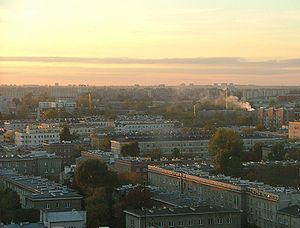Grochów

Grochów is a district of
Communist authorities
, Grochów had not transformed into a strictly industrial district, even though it had been such in the 19th century.
History
For centuries, Grochów was a small village south-east of
Swedish Invasion of 1656 wreaked destruction, and a prosperous village was completely looted and burnt to the ground; only 9 houses remained. In 1780 Grochów was bought by King Stanisław August Poniatowski who gave it to his nephew, Prince Stanisław Poniatowski
. The latter soon built a small manor in the village, the first house there to be constructed of anything besides wood. He soon subdivided the village into eight separate properties, selling each to a different family. This led to a period of prosperity as the village was rebuilt and began to serve as one of the most important centres of grain production and trade for the nearby city of Warsaw.
The
Kingdom of Poland
as a puppet state of Germany, the village of Grochów became a part of Warsaw and a seat of Grochów Area of Warsaw (Komisariat XVII Grochowski).
After Poland regained her independence in 1918, Grochów and all the nearby villages started to grow rapidly. Grochów itself soon lost its rural and industrial character and was gradually converted into a borough built up with blocks of flats. New streets were paved, gas, running water and sewer networks were installed and it soon became one of the most popular places for companies and societies to build cheap houses for their employees and members.
During World War II Grochów escaped destruction, and from the early 1960s, it saw a new period of rapid growth and expansion as new areas were heavily built up with blocks of flats.
